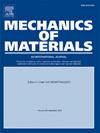Shock compaction of porous compounds with application to PBX-9501 and HMX
IF 3.4
3区 材料科学
Q2 MATERIALS SCIENCE, MULTIDISCIPLINARY
引用次数: 0
Abstract
This report pursues assessment and analysis of earlier experimental shock wave studies of HMX based PBX-9501 explosive material, a mixture of HMX molecular crystal and polymer binder. The effort also undertakes exploring underlying physics of the dynamic compaction and deformation of granular mixtures, and in pursuing compaction model improvements relevant to the shock wave equation-of-state. The model development is applied to experimental unreacting shock strength and Hugoniot data on modestly porous PBX-9501 material tested at Los Alamos National Laboratory (LANL) in the 1980's and again in the 1990's. Time-resolved shock wave experiments lend insights into the energy dissipation dynamics. Complementary detailed material microstructure studies constrain dissipation mechanisms on the microscale. Pore compaction is modelled and the potential for heterogeneous hot-spot formation is assessed. Results of the effort uncover details of the unreacting shock compaction response of this mixture material. Specifics of shock wave structure and the dependence of structure on shock amplitude are explored that lend insights into microstructure dissipation mechanisms responsible for onset of reaction. The report closes with a perspective on dissipation dynamics within the unreacting structured shock wave response of PBX 9501 explosive.
多孔化合物在PBX-9501和HMX上的应用
本报告对基于HMX的PBX-9501炸药材料(HMX分子晶体和聚合物粘合剂的混合物)的早期实验冲击波研究进行了评估和分析。这项工作还致力于探索颗粒混合物的动态压实和变形的潜在物理原理,并寻求与激波状态方程相关的压实模型改进。该模型开发应用于20世纪80年代和90年代在洛斯阿拉莫斯国家实验室(LANL)测试的中等多孔PBX-9501材料的实验非反应冲击强度和Hugoniot数据。时间分辨激波实验有助于深入了解能量耗散动力学。补充详细的材料微观结构研究限制了微观尺度上的耗散机制。模拟了孔隙压实作用,并评估了非均质热点地层的可能性。努力的结果揭示了这种混合材料的非反应冲击压实响应的细节。探讨了激波结构的特点和结构对激波振幅的依赖性,从而深入了解了引起反应的微观结构耗散机制。报告最后对PBX 9501炸药非反应结构激波响应中的耗散动力学进行了分析。
本文章由计算机程序翻译,如有差异,请以英文原文为准。
求助全文
约1分钟内获得全文
求助全文
来源期刊

Mechanics of Materials
工程技术-材料科学:综合
CiteScore
7.60
自引率
5.10%
发文量
243
审稿时长
46 days
期刊介绍:
Mechanics of Materials is a forum for original scientific research on the flow, fracture, and general constitutive behavior of geophysical, geotechnical and technological materials, with balanced coverage of advanced technological and natural materials, with balanced coverage of theoretical, experimental, and field investigations. Of special concern are macroscopic predictions based on microscopic models, identification of microscopic structures from limited overall macroscopic data, experimental and field results that lead to fundamental understanding of the behavior of materials, and coordinated experimental and analytical investigations that culminate in theories with predictive quality.
 求助内容:
求助内容: 应助结果提醒方式:
应助结果提醒方式:


